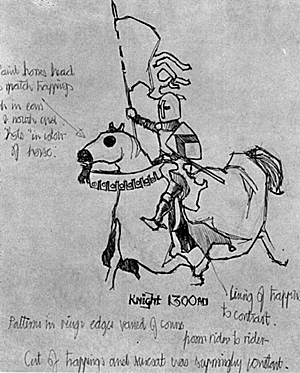
Airfix conversions are simple affairs or may be as difficult as one wishes. The following was written before Airfix brought out figures of the Medieval period and seems to be something in the nature of a work of art. -- DF.
The idea of constructing a Knight in miniature 00 scale was at first a daunting one. Indeed I had shelved the idea until I was laid up with flu and ones facilities for model making while in bed are naturally limited. I was playing with paper sculpture when the obvious application hit me.
Since at this scale the bandings of the horse and the knights surcoat are the main difficulties I concentrated on them. Stiff paper cut to the patterns in the sketches was tried but of course looked exactly like stiff paper! I then tried damp paper which was better but still artificial when dry.
After much experiment I used fine tissue (paper hankies) soaked in Shellac which adhered to the horse previously coated and with blanket roll removed. I wanted to capture the vigorous folds caused by the horses movement and so characteristic of manuscript drawings so I moulded up the tissue using fine tweezers dipped in water to prevent them sticking to the tissue. After much fiddling, swearing, and lots of glue coated tissue all over the sheets, I reached the desired effect.
The front and rear of the horse thus treated, I gave the bandings several coats to fill the grain of the tissue (very apparent in this small scale) and which also stiffened it. The reins and saddle are obvious from the sketch as is the simple work on the knight himself.
The banner was constructed in the same way as the surcoat and trappings, the lance being a fine broom bristle sanded to a point.
 Only painting remained. I chose the late 13th century period as armour was Still
basically mail. The sleeves of the original figure are thus painted to represent mail, while the chest and back are painted as the surcoat. Chain mail even when new was very dull in appearance and with little wear soon became dulled with rust, impossible to effectively clean, it rapidly became drab silver brown-grey in colour. Easily made from black, red and a little silver. Helm and shoulder roundels are bright steel.
Only painting remained. I chose the late 13th century period as armour was Still
basically mail. The sleeves of the original figure are thus painted to represent mail, while the chest and back are painted as the surcoat. Chain mail even when new was very dull in appearance and with little wear soon became dulled with rust, impossible to effectively clean, it rapidly became drab silver brown-grey in colour. Easily made from black, red and a little silver. Helm and shoulder roundels are bright steel.
At this period simple heraldry was still much in vogue, which is fortunate because little elaborate heraldry can appear on a shield only slightly longer than a quarter of an inch. Belts were often velvet covered in a colour contrasting with that' predominant in the coat-of-arms.
The linings of surcoat and horse trappings turned back in the wind also were of contrasting colours.
As a final touch tiny spurs were made from fuse wire looped round the ankle and twisted to a point at the heel.
I have now made four of these figures and although construction is straight forward the last took as long as the first as only by trial and errcr can the correct hang of the trappings be aspired. And this is the secret of the figure's success.
Although this excellent method was devised before Airfix brought out the "Sheriff of Nottingham" box, when there was need for such a conversion it raises an interesting point. Why should 20(25)mm figures only be used for wargames? Why not conversions that turn an Airfix figure into a collector's piece? --DF
Back to Table of Contents -- Wargamer's Newsletter # 95
To Wargamer's Newsletter List of Issues
To MagWeb Master Magazine List
© Copyright 1970 by Donald Featherstone.
This article appears in MagWeb (Magazine Web) on the Internet World Wide Web.
Other military history articles and gaming articles are available at http://www.magweb.com